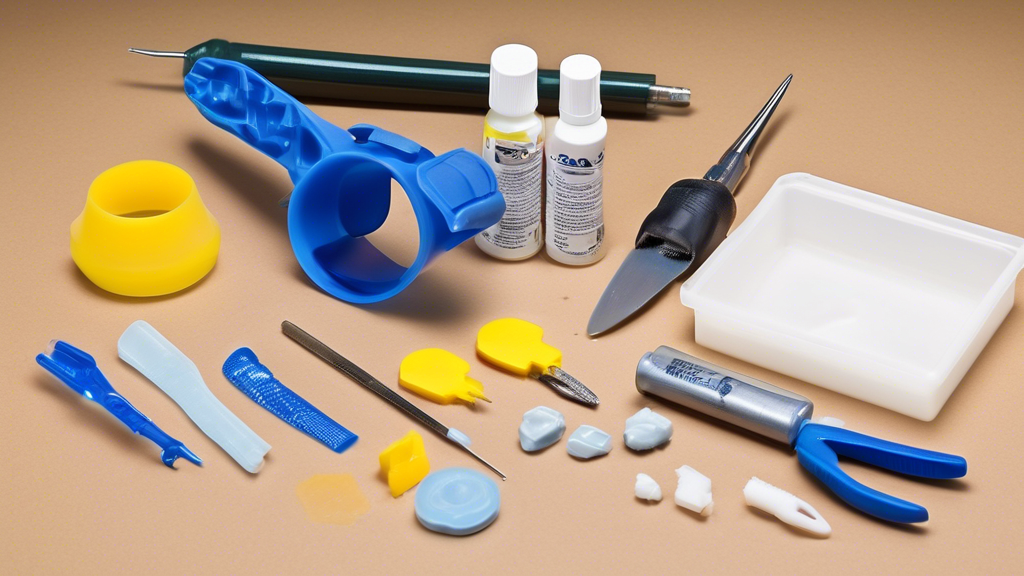Does Wood Glue Work on Plastic? Understanding Adhesive Compatibility
If you’ve found yourself staring at that mismatched set of materials on your workbench, pondering the eternal question, Does wood glue work on plastic? you’re not alone. It’s one of those conundrums that seem to pop up right when you’re smack dab in the middle of a project. As intuitive as it might be to reach for the trusty bottle of wood glue for every bonding need, the magic potion that holds your wooden masterpieces together is a bit of a one-trick pony when it comes to certain materials. Imagine trying to get a ticket to the hottest concert in town with a library card—sure, they’re both rectangles with information on them, but one of them just doesn’t quite do the trick.
Wood glue, famously water-based and perfect for those friendly, porousites like wood, gets a little shy around the more non-porous personalities of the material world, namely plastics. Plastics, with their slick, sometimes glossy demeanor, have a tendency to brush off wood glue’s earnest attempts at hanging out. It’s not that the wood glue is anti-social; it’s just that its party tricks only work at the wooden festivities. Understanding this is key—wood and plastic aren’t just incompatible by nature but by the very fibers (or lack thereof) that compose them.
Fear not, though, because like any good team of problem solvers, where one adhesive steps down, another one steps up. Enter the world of plastic-dedicated adhesives—superwelders like epoxy, cyanoacrylate, and those covert ops adhesives designed just for plastic. These are your go-to squad members when you need a bond that stands the test of time and inevitable structural assessments by the most curious of curious cats. From taking a walk on the wild side with epoxy’s intense bonding strength to the quick-dry precision of super glue, we’ll walk through what makes them tick and how they can save your project from the brink.
So whether you’re armed with the most basic kit or ready to wield advanced tools like the woodworking wizard you aspire to be, remember: in the world of adhesives, compatibility isn’t an end-all but merely an invitation to explore alternatives. So pull up a seat, grab that coffee, and let’s dive into the sticky yet fascinating world of adhesive compatibility, where there’s always a solution, even if your wood glue didn’t quite make friends with your plastic.
Understanding Adhesive Types: Evaluating Wood Glue and Plastic Properties
Ah, the wonder of wood glue, the unsung hero of many woodworking projects, forming bonds that put even the strongest friendships to shame. But does wood glue work on plastic? Not exactly, but let’s get into the why. Wood glue, my dear woodworking comrades, is primarily a water-based adhesive that loves to hug the fibers of porous surfaces like wood. Imagine it as nature’s matchmaker for wood fibers, allowing them to connect and hold hands forever—or at least until our next creative whim. The water within wood glue penetrates the wood’s surface, and when it dries, it creates a strong bond that stands the test of time, or at least the occasional oopsy.
Now, let’s escort our focus from the wooded wonderland to the complicated character of plastic. Picture plastic as the cool, enigmatic cousin that doesn’t like to play well with others, particularly if those others are water-based adhesives. Plastic, in all its shiny glory, tends to have a non-porous surface, meaning that there’s nowhere for the wood glue to seep in and do its bonding magic. It’s like trying to get Velcro to stick on glass—not exactly a match made in heaven.
Within the plastic family, there are a few common types that you might encounter in your project escapades, such as polyethylene, polypropylene, and polyvinyl chloride. These cool cats are known for their resistance to water and their sleek, smooth surfaces, which, while great for everything from packaging to pipes, don’t exactly scream “stick to me, wood glue!”
And don’t fret if you’ve already tried using wood glue on plastic. We’ve all been there, silently whispering sweet nothings to our stubborn project, willing it to stick. But when it comes to the structural differences between wood and plastic, it’s not you—it’s them. Wood, with its fibrous, welcoming nature, contrasts starkly with plastic’s slick, non-receptive demeanor. These differences play a pivotal role in how well adhesives work, or, in this case, don’t work.
If you’ve ever found yourself questioning your life choices while staring at pieces of plastic that refuse to adhere, know that you’re not alone. The adhesive misadventures are part of our shared journey. My own project mishap involved a painstakingly crafted wooden masterpiece meeting a plastic shelf, only for the two to part ways almost immediately. You’d think they were having a spat over whose turn it was to do the dishes. But, much like with familial disagreements, the resolution lies in understanding the needs and boundaries of each material involved.
So, what does this mean for our creative endeavors? If you’re trying to bind a piece of plastic with wood glue, it’s bound to be a frustrating experience. Instead, it might be time to consider alternatives specifically crafted for the complex character of plastic (cue teaser for our next segment). Recognizing the limits of wood glue doesn’t mark the end of our creativity—it merely opens doors to new materials and methods. Remember, every stumble is just another step in our shared woodworking adventure.
And as always, remember that whether you’re wielding a basic toolkit or operating machinery of wizard-like complexity, you’ve got a community here rooting for you. Mistakes are our best teachers, and perseverance is the ultimate tool in your woodworking toolbox. Stick with it—and the right glue—and you’ll come out on top, even if your original project doesn’t.
Click Here For The World’s Largest Collection of 16,000 Woodworking Plans

Exploring Alternatives: Best Practices for Gluing Plastic
Alright, folks, let’s get down to the nitty-gritty of glue types because not all glues are created equal—especially when it comes to sticking plastic bits together. The burning question: does wood glue work on plastic? In short, not really. It’s like trying to fix a spaceship with duct tape—it might hold it together for a second, but you’re probably gonna have a problem in orbit. But fear not! There are some real adhesive superheroes ready to swoop in and save the day—er, your plastic project.
Meet the Plastic-Fighting Trio
First up in our lineup is epoxy, the big burly bouncer of adhesives. Epoxy thrives when strength is key, offering a robust, resilient bond that could probably survive a hurricane. Fun fact: it’s a two-part adhesive, so it’s a bit like making a cake—you gotta mix the resin and the hardener to get the magic. Not only does it cure strong, but it does so even in Devilish Technicolor shades if you’re feeling fancy. Drying times can vary, often around 5 to 30 minutes, so you have a small window for repositioning before it sets like concrete. Got a light saber that needs tweaking? Epoxy’s your Jedi master!
Next in our adhesive Avengers is cyanoacrylate, or super glue to us regular beings. Think of it as the sprinter of glues, dashing to create a quick bond faster than you can say oops. With a drying time of mere seconds, it’s ideal for projects where patience isn’t a virtue you possess. But beware! Super glue loves your skin as much as it loves plastic, so keep those fingers safe, or you might find yourself seriously attached (pun entirely intended). Designed for strength and speed, cyanoacrylate is perfect for mending small, intricate cracks where pinpoint precision is key.
Finally, for those who love a specialized approach, we have plastic-specific adhesives. These are like those friends who always seem to know exactly what’s needed in a crisis. They’re formulated specifically for plastic, so they get along with it like peanut butter and jelly. These adhesives are often a one-part formula, meaning just like ready-to-eat meals, there’s minimal faff before the bonds start forming. These bad boys are especially handy in projects where oil-based plastics are involved, as they’ve been mixed with just the right recipe to handle those sneaky chemical compositions. Here’s a little tip: check your adhesive’s compatibility on the back label before you start any serious sticking.
Prepping Your Plastic for Maximum Bonding
Before you go all sticky, it’s time to prep your plastic surfaces. Picture this: your plastic bit is like your friend before a big date—it’s gotta look (and be) clean to make a good impression. Start with a thorough wash using soap and water to remove dust, grease, and fingerprints. Give it a nice rinse and let it air dry thoroughly. It’s like prepping your canvas before you try painting for the first time (I know, I know, Bob Ross made it look too easy).
Now, here’s where we get a bit gritty; literally. Most plastics have a notoriously slippery surface, kinda like trying to hug a greased pig—good luck. What you want is a bit of texture, so lightly sand the surface with fine-grit sandpaper. This process, much like putting on exfoliating scrub before shaving, creates micro-abrasions to give your glue something to latch onto. Promptly wipe away any sanding dust with a clean, damp cloth. And there you have it, your plastic is properly prepped and primed.
In conclusion, while does wood glue work on plastic is a question worthy of a head scratch, the truth is in the alternatives. With some thoughtful adhesive selection and a little surface prep, you’ll soon have a bond that might last longer than some Hollywood marriages. And if you find yourself floating through the wonderful world of trial and error, remember: every slip-up is just a lesson in mastering the craft. Now go forth and glue with confidence!
In conclusion, when pondering the question, Does wood glue work on plastic? the answer leans more toward the side of not quite. Wood glue, with its origins rooted in bringing lumber love affairs together, simply doesn’t have the right chemistry to woo plastic—a match more mismatched than peanut butter on a hot dog. The water-based nature of wood glue makes it great for porous surfaces like wood, where it can soak in and create a strong bond. However, plastic, with its smooth and often shiny demeanor, seems to chuckle in the face of such adhesive advances, remaining staunchly non-porous and aloof.
That said, don’t hang up your glue brush just yet! When it comes to plastic, it’s all about finding the adhesive soulmate. Enter epoxy, cyanoacrylate (aka super glue), and those dashing plastic-specific adhesives, each bringing their own strengths to the table. Whether it’s the robust bond strength or the speedy drying time you’re after, these alternatives are well-equipped to deal with the commitment-phobic tendencies of plastic surfaces.
Before you start bonding, remember that a little preparation goes a long way—kind of like warming up before a big game, but less sweat and more surface scruff. Cleaning your plastic surface and giving it a gentle rough-up with some sandpaper can enhance your adhesive efforts, much like putting on your favorite Crocs can improve your workbench comfort.
Wood glue has its rightful place in the woodworking world, cementing its legacy in the realm of wood joinery. Yet, for those cross-material adventures where wood meets plastic, choosing the right adhesive is your surest path to success. Don’t fret when things don’t stick right away. Even the most seasoned artisans have faced the frustration of a failed bond—I’ve personally had my fair share of splinter-loaded, glue mishaps that required more creativity than you’d think to disguise. So grab the right glue, prep like a pro, and may your future projects stick together better than a dance floor during YMCA at a wedding reception!
Click Here For The World’s Largest Collection of 16,000 Woodworking Plans

